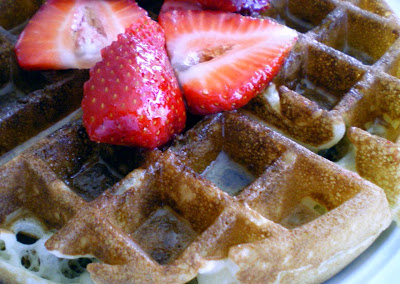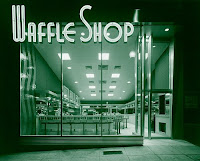
I love waffles. That is, I love good waffles which exclude ones that come frozen, are made from a mix or taste like cleated pancakes. Waffles should be light, golden brown and crispy. Waffles are easy to make so I’m not sure why the alternatives to homemade have become so universal. Perhaps it’s for the lack of a waffle iron. This must have been one of the first electric appliances, though waffles were around long before it advent. Its origins go back to the Middle Ages. In fact, they were universally sold outside of churches on saint's days and at other special religious celebrations. Competition among the waffle sellers became so fierce that King Charles IX of France had to rule that waffle vendors stay at least six feet from one another at all times.

The first hinged waffle iron for use on top of a stove was patented in the U.S. in 1869. But waffles didn’t really become popular until the invention of the electric waffle maker in 1926 by Charles M. Cole. In the decade that followed, waffles became the rage, diners specializing in the delicacy sprung up everywhere and almost no home was without a waffle iron. What we now call the Belgian waffle—a thicker variety with deeper indentations—was introduced at the 1964 New York World's Fair. Covered with fresh strawberries and mounds of whipped cream it was an instant hit.
 Most of the waffle irons sold today are of the Belgian type, many with a nonstick surface but it’s still possible to find the older, traditional waffle maker (both new and used) which produce a larger and thinner waffle.
Most of the waffle irons sold today are of the Belgian type, many with a nonstick surface but it’s still possible to find the older, traditional waffle maker (both new and used) which produce a larger and thinner waffle.
In the United States, waffles are most often eaten warm at breakfast or brunch. Many soul food restaurants—especially in the Harlem are of New York—serve waffles with fried chicken. The Pennsylvania Dutch commonly used a plain waffle as the base for stewed chicken. In the Netherland, Belgium Sweden and Italy variations of the waffle are popular as a dessert or confection.
The Waffle House chain has more than 1,000 restaurants in 24 states and claims to have sold more than 500 million waffles. Several restaurants in Madison still do waffles right.
Here is my list of “Best of Madison” waffles, all are the Belgian variety. If you like old style, you’re stuck making them at home and I’ve included my two favorite recipes at the end.
The Old Fashioned serves your basic waffles but it comes with pure Wisconsin maple syrup, Grand Marnier-flavored whipped cream and powdered sugar. You can also add a fresh fruit topping (extra) if you like.
Café Continental makes malted waffles with a choice of several toppings including a New Orleansesque bananas Foster variety.
Sardine has two different waffles, one is topped with an apple compote and crème fraiche. The other is an unusual buckwheat waffle that comes with whipped orange-cinnamon butter and, sliced banana. Both come with maple syrup.
BrasserieV has a waffle topped with blueberries, bananas, whipped cream and real maple syrup.
Pancake Café offers several waffles served with syrup, fruit toppings or pecans but the most unique is the one with bacon baked inside. This is the only place on the list where you can get your waffle fix every day of the week (the other restaurants only serve brunch on the weekend).
Buttermilk Waffles
Classic waffles and easy to make the recipe comes from Tennessee. You can cut in half if you want to make a smaller portion and leftover batter will keep covered in the refrigerator for a week (it may discolor but just stir well before cooking).
1½ cups flour (preferably, pastry flour but all-purpose will work)
½ cup cornstarch
1 teaspoon baking powder
½ teaspoon baking soda
1 teaspoon salt
2 cups buttermilk
2/3 cup corn oil
2 eggs
4 teaspoons sugar
1 teaspoon vanilla extract
Butter
Maple syrup
In a medium bowl, combine the flour, cornstarch, baking powder, baking soda, and salt; mix well. Add the milk, vegetable oil, egg, sugar and vanilla and mix well. Let the batter sit for 30 minutes.
Preheat a waffle iron.
Do not use non-stick spray on the waffle iron; the oil in the batter will allow the waffle to release easily. Follow the directions on your waffle iron to cook the waffles. Serve immediately with butter and syrup.
Makes 8 large waffles.
Raised Waffles
These waffles are the best. They require a little extra effort (you have to start the night before) but are well worth it. Light and crispy, they are better made in a traditional waffle iron rather than the Belgian style.
½ teaspoon sugar
½ cup warm water
1 package active dry yeast
2 cups whole milk
½ cup (1 stick) unsalted butter, cut into tablespoon-size pieces
1 teaspoon salt
1 teaspoon sugar
2 cups all-purpose flour
2 eggs
¼ teaspoon baking soda
Dissolve the ½ teaspoon sugar in the warm water; add yeast, dissolve and let proof for 8 to 10 minutes.
Heat the milk and butter over low heat until the butter melts. Cool to lukewarm.
Combine milk butter mixture with salt, 1 teaspoon sugar, flour and proofed yeast in the bowl of an electric mixer. Beat on medium speed to combined, 2 to 3 minutes. Cover bowl and let stand overnight at room temperature.
Preheat a waffle iron.
Add eggs and baking soda to batter and combine well using a whisk. Batter may be stored in a covered container in the refrigerator for several days.
Use about ½ cup batter (it will be thin). Let the batter set up (about 30 seconds) before lowering the waffle iron lid. Cook until golden brown (about 5 minutes).
Makes 8 large waffles.

The first hinged waffle iron for use on top of a stove was patented in the U.S. in 1869. But waffles didn’t really become popular until the invention of the electric waffle maker in 1926 by Charles M. Cole. In the decade that followed, waffles became the rage, diners specializing in the delicacy sprung up everywhere and almost no home was without a waffle iron. What we now call the Belgian waffle—a thicker variety with deeper indentations—was introduced at the 1964 New York World's Fair. Covered with fresh strawberries and mounds of whipped cream it was an instant hit.
 Most of the waffle irons sold today are of the Belgian type, many with a nonstick surface but it’s still possible to find the older, traditional waffle maker (both new and used) which produce a larger and thinner waffle.
Most of the waffle irons sold today are of the Belgian type, many with a nonstick surface but it’s still possible to find the older, traditional waffle maker (both new and used) which produce a larger and thinner waffle.In the United States, waffles are most often eaten warm at breakfast or brunch. Many soul food restaurants—especially in the Harlem are of New York—serve waffles with fried chicken. The Pennsylvania Dutch commonly used a plain waffle as the base for stewed chicken. In the Netherland, Belgium Sweden and Italy variations of the waffle are popular as a dessert or confection.
The Waffle House chain has more than 1,000 restaurants in 24 states and claims to have sold more than 500 million waffles. Several restaurants in Madison still do waffles right.

Here is my list of “Best of Madison” waffles, all are the Belgian variety. If you like old style, you’re stuck making them at home and I’ve included my two favorite recipes at the end.
The Old Fashioned serves your basic waffles but it comes with pure Wisconsin maple syrup, Grand Marnier-flavored whipped cream and powdered sugar. You can also add a fresh fruit topping (extra) if you like.
Café Continental makes malted waffles with a choice of several toppings including a New Orleansesque bananas Foster variety.
Sardine has two different waffles, one is topped with an apple compote and crème fraiche. The other is an unusual buckwheat waffle that comes with whipped orange-cinnamon butter and, sliced banana. Both come with maple syrup.
BrasserieV has a waffle topped with blueberries, bananas, whipped cream and real maple syrup.
Pancake Café offers several waffles served with syrup, fruit toppings or pecans but the most unique is the one with bacon baked inside. This is the only place on the list where you can get your waffle fix every day of the week (the other restaurants only serve brunch on the weekend).
Buttermilk Waffles
Classic waffles and easy to make the recipe comes from Tennessee. You can cut in half if you want to make a smaller portion and leftover batter will keep covered in the refrigerator for a week (it may discolor but just stir well before cooking).
1½ cups flour (preferably, pastry flour but all-purpose will work)
½ cup cornstarch
1 teaspoon baking powder
½ teaspoon baking soda
1 teaspoon salt
2 cups buttermilk
2/3 cup corn oil
2 eggs
4 teaspoons sugar
1 teaspoon vanilla extract
Butter
Maple syrup
In a medium bowl, combine the flour, cornstarch, baking powder, baking soda, and salt; mix well. Add the milk, vegetable oil, egg, sugar and vanilla and mix well. Let the batter sit for 30 minutes.
Preheat a waffle iron.
Do not use non-stick spray on the waffle iron; the oil in the batter will allow the waffle to release easily. Follow the directions on your waffle iron to cook the waffles. Serve immediately with butter and syrup.
Makes 8 large waffles.
Raised Waffles
These waffles are the best. They require a little extra effort (you have to start the night before) but are well worth it. Light and crispy, they are better made in a traditional waffle iron rather than the Belgian style.
½ teaspoon sugar
½ cup warm water
1 package active dry yeast
2 cups whole milk
½ cup (1 stick) unsalted butter, cut into tablespoon-size pieces
1 teaspoon salt
1 teaspoon sugar
2 cups all-purpose flour
2 eggs
¼ teaspoon baking soda
Dissolve the ½ teaspoon sugar in the warm water; add yeast, dissolve and let proof for 8 to 10 minutes.
Heat the milk and butter over low heat until the butter melts. Cool to lukewarm.
Combine milk butter mixture with salt, 1 teaspoon sugar, flour and proofed yeast in the bowl of an electric mixer. Beat on medium speed to combined, 2 to 3 minutes. Cover bowl and let stand overnight at room temperature.
Preheat a waffle iron.
Add eggs and baking soda to batter and combine well using a whisk. Batter may be stored in a covered container in the refrigerator for several days.
Use about ½ cup batter (it will be thin). Let the batter set up (about 30 seconds) before lowering the waffle iron lid. Cook until golden brown (about 5 minutes).
Makes 8 large waffles.









